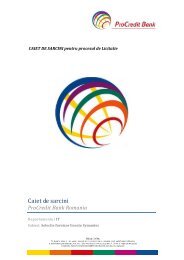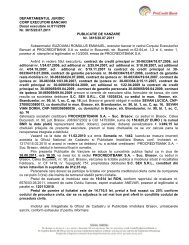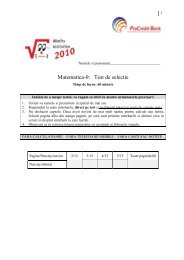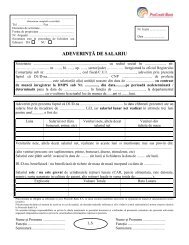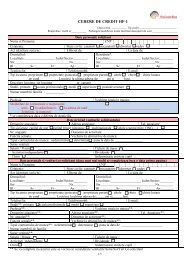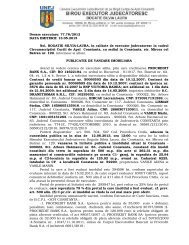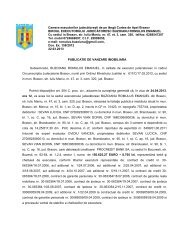Annual Report 2010 - ProCredit Bank
Annual Report 2010 - ProCredit Bank
Annual Report 2010 - ProCredit Bank
Create successful ePaper yourself
Turn your PDF publications into a flip-book with our unique Google optimized e-Paper software.
Compliance with <strong>Bank</strong> standards is supported by a programme<br />
of periodical reviews undertaken by Internal Audit. The results of<br />
Internal Audit reviews are discussed with the management of the<br />
business unit to which they relate, with summaries submitted to<br />
the Audit Committee and senior management of the <strong>Bank</strong>.<br />
5. Use of estimates and judgements<br />
The <strong>Bank</strong> makes estimates and assumptions that affect the reported<br />
amounts of assets and liabilities within the next financial year.<br />
Estimates and judgements are continually evaluated and are based<br />
on historical experience and other factors, including expectations<br />
of future events that are believed to be reasonable under the circumstances.<br />
Management discusses with the Audit Committee the development,<br />
selection and disclosure of the <strong>Bank</strong>’s critical accounting policies<br />
and estimates, and the application of these policies and estimates.<br />
These disclosures supplement the commentary on financial risk<br />
management (see note 4).<br />
Key sources of estimation uncertainty<br />
Impairment losses on loans and advances<br />
Assets accounted for at amortised cost are evaluated for impairment<br />
on a basis described in accounting policy 3(h)(vii).<br />
The specific counterparty component of the total allowances for<br />
impairment applies to financial assets evaluated individually for<br />
impairment and is based upon management’s best estimate of the<br />
present value of the cash flows that are expected to be received.<br />
In estimating these cash flows, management makes judgements<br />
about counterparty’s financial situation and the net realisable<br />
value of any underlying collateral. Each impaired asset is assessed<br />
on its merits, and the workout strategy and estimate of cash flows<br />
considered recoverable are independently approved by the Credit<br />
Risk function.<br />
Collectively assessed impairment allowances cover credit losses<br />
inherent in portfolios of loans and advances with similar credit<br />
risk characteristics when there is objective evidence to suggest<br />
that they contain impaired loans and advances, but the individual<br />
impaired items cannot yet be identified. In assessing the need for<br />
collective loss allowances, management considers factors such as<br />
credit quality, portfolio size, concentrations and economic factors.<br />
In order to estimate the required allowance, assumptions are made<br />
to define the way inherent losses are modelled and to determine<br />
the required input parameters, based on historical experience and<br />
current economic conditions. The accuracy of the allowances depends<br />
on the estimates of future cash flows for specific counterparty<br />
allowances and the model assumptions and parameters used<br />
in determining collective allowances.<br />
The <strong>Bank</strong> reviews its loan portfolios to assess impairment at least<br />
on a semi-annual basis. In determining whether an impairment loss<br />
should be recorded in the income statement, the <strong>Bank</strong> makes judgments<br />
as to whether there is any observable data indicating that<br />
there is a measurable decrease in the estimated future cash flows<br />
from a portfolio of loans before the decrease can be identified with<br />
an individual loan in that portfolio. This evidence may include observable<br />
data indicating that there has been an adverse change<br />
in the payment status of borrowers in a group, or national or local<br />
economic conditions that correlate with defaults on assets in the<br />
group. Management uses estimates based on historical loss experience<br />
for assets with credit risk characteristics and objective evidence<br />
of impairment similar to those in the portfolio when scheduling<br />
its future cash flows. The methodology and assumptions used<br />
for estimating both the amount and timing of future cash flows are<br />
reviewed regularly to reduce any differences between loss estimates<br />
and actual loss experience.<br />
Financial Statements 65<br />
Hence, the <strong>Bank</strong> has estimated the impairment loss provision for<br />
loans and advances to customers based on the internal methodology<br />
and assessed that no further provision for impairment losses is<br />
required except as already provided for in the financial statements.<br />
Critical accounting judgements in applying the <strong>Bank</strong>’s accounting<br />
policies<br />
Fair value of financial instruments<br />
The <strong>Bank</strong> measures fair values using the following fair value hierarchy<br />
that reflects the significance of the inputs used in making the<br />
measurements:<br />
• Level 1: Quoted market price in an active market for an identical<br />
instrument.<br />
• Level 2: Valuation techniques based on observable inputs. This<br />
category includes instruments valued using: quoted market<br />
prices in active markets for similar instruments; quoted prices<br />
for similar instruments in markets that are considered less<br />
than active; or other valuation techniques where all significant<br />
inputs are directly or indirectly observable from market data.<br />
• Level 3: Valuation techniques using significant unobservable<br />
inputs. This category includes all instruments where the valuation<br />
technique includes inputs not based on observable data<br />
and the unobservable inputs could have a significant effect on<br />
the instrument’s valuation. This category includes instruments<br />
that are valued based on quoted prices for similar instruments<br />
where significant unobservable adjustments or assumptions<br />
are required to reflect differences between the instruments.<br />
The <strong>Bank</strong> determined the fair value of the treasury bills issued by<br />
the Ministry of Public Finance of Romania, classified as availablefor-sale<br />
financial instruments, using bid quotations in an active<br />
market (e.g. Reuters) at the balance sheet date.<br />
The objective of valuation techniques is to arrive at a fair value determination<br />
that reflects the price of the financial instrument at the<br />
reporting date that would have been determined by market participants<br />
acting at arm’s length.<br />
Availability of observable market prices and model inputs reduces<br />
the need for management judgement and estimation and also reduces<br />
the uncertainty associated with determination of fair values.<br />
Availability of observable market prices and inputs varies depending<br />
on the products and markets and is prone to changes based on<br />
specific events and general conditions in the financial markets.<br />
The fair value of financial instruments that are not traded in an<br />
active market (for example, unlisted treasury securities, bonds<br />
and certificates of deposit) is determined by using valuation techniques.<br />
The management uses its judgment to select the valuation<br />
method and make assumptions that are mainly based on market<br />
conditions existing at each balance sheet date.<br />
Valuation models that employ significant unobservable inputs require<br />
a higher degree of management judgement and estimation in<br />
determination of fair value. Management judgement and estimation<br />
are usually required for selection of the appropriate valuation<br />
model to be used, determination of expected future cash flows on<br />
the financial instrument being valued, determination of probability<br />
of counterparty default and prepayments and selection of appropriate<br />
discount rates.<br />
In determining fair values, the <strong>Bank</strong> uses averages of reasonably<br />
possible alternative inputs. When alternative assumptions are<br />
available within a wide range, judgements exercised in selecting<br />
the most appropriate point in the range include evaluation of the<br />
quality of the sources of inputs (for example, the experience and<br />
expertise of the brokers providing different quotes within a range,<br />
giving greater weight to a quote from the original broker of the instruments<br />
who has the most detailed information about the instrument)<br />
and availability of the corroborating evidence in respect of<br />
some inputs within the range.




